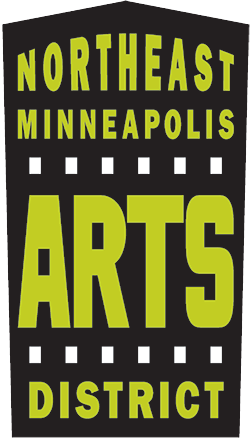Compiled by Josh Blanc
The murder of George Floyd has marked a new consciousness in Minneapolis and beyond. Artists from the Northeast Minneapolis Arts District with different vantage points, and who have been working on issues of equality and justice for many years, are engaging on the front lines in this transformative moment.
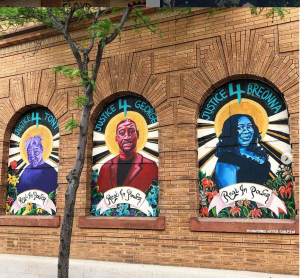
Using the hashtag #creativesaftercurfew, Leslie Barlow and about two dozen other predominantly BIPOC (Black/indigenous/people of color) artists are part of a crew painting murals on boarded-up businesses. Barlow, featured in the StarTribune June 8, “has emerged as a leading artist in the work to speak to the pain of George Floyd’s murder, and the strengths and a way forward for Black people.” Leslie is primarily an oil painter, sharing stories through figural relationships that explore the politics of representation, identity, otherness, and racial constructs. She has a Master of Fine Arts from the Minneapolis College of Art and Design, and a studio in the Northrup King Building.
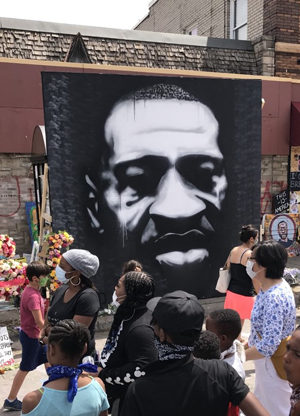
Minneapolis native Peyton Scott Russell, better known as Peyton, has a Bachelor of Fine Arts from the School of the Art Institute of Chicago, and has been a professional artist and arts instructor for over three decades. “Creating street art is the best way to reach people,” he said. “I wanted to use the most effective tool I have—my art—to contribute.” His “George Floyd: Icon of an American Revolution” mural was picked up by the New York Times as an image of the 38th and Chicago memorial, and has gone viral all over the world.
“The original intent was a guerilla action to support the people and install at night in a drop-and-run mission. However, the installations became more public because of the size and weight, and the need to respect the sacred space.” Installation of the murals required a crew which, besides Peyton, included John Hock, Ben Janssens, and Andrew McGuffie, who also built the plywood canvases. Hock is founder of Franconia Sculpture Park and artistic director of NE Sculpture, and Janssens is co-founder of Solid Metal Arts and founder of SignMinds; they and Peyton are based in Northeast Minneapolis at Casket Arts. McGuffie is a Twin Cities artist.
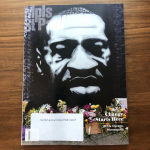
The image is based on a photo “used as a symbol and reminder that Black Lives Matter; injustice for one = injustice for all; the beginning of a revolution; and the desperate need for law enforcement reform. The mural’s imagery also represents everything wrong with a system that leads us to this point. Mr. Floyd’s face . . . represent[s] a strong Black American face and experiences that are repeated generation after generation. My hope is that we will see real change, understanding, and a restructuring of a system that allows equality and equity for all as the true ideal of this country,” said Peyton.
 Reggie LeFlore, whose studio is in the Northrup King Building, appeared in a panel discussion of Black artists, “Black Art in the Era of Protest: A Virtual Conversation” on June 18; it’s available online. For background: In the wake of the 1968 Detroit rebellion, collectives like AfriCOBRA movement (African Commune of Bad Relevant Artists) gave birth to the concept of art-making as a radical action. They discussed commodification of Black art, art as a political weapon through radical self-expression, the history of communication through street art, and where these important murals should end up.
Reggie LeFlore, whose studio is in the Northrup King Building, appeared in a panel discussion of Black artists, “Black Art in the Era of Protest: A Virtual Conversation” on June 18; it’s available online. For background: In the wake of the 1968 Detroit rebellion, collectives like AfriCOBRA movement (African Commune of Bad Relevant Artists) gave birth to the concept of art-making as a radical action. They discussed commodification of Black art, art as a political weapon through radical self-expression, the history of communication through street art, and where these important murals should end up.
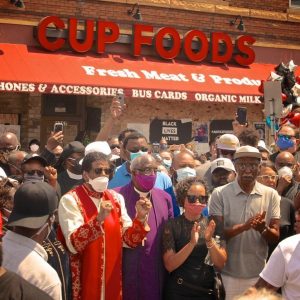
Mark Wojahn, documentary filmmaker and curator of Casket Cinema since 2008, grew up in South Minneapolis. Tuesday, May 26th was the first night of protests following Floyd’s murder. When Wojahn first went to see the situation Wednesday morning, he said police did not have any control; he’d never felt anarchy and chaos before. He saw Target being looted and started to film. A guy from a passing car yelled, “Turn off your camera, white man.” Wojahn yelled back, “It is my neighborhood too.” The driver responded, “Fuck you.”
Wojahn said “99.5% of protesters were peaceful. People want change. They want our city law enforcement to change.” He noted that the protesters have been strategic in going to the mayor’s residence, taking down Columbus statues, and choosing how to fight this battle. Wojahn is hoping there will be a wider acceptance of street art, which he has been documenting. “Our city has not been accepting. It is a very populist vein of art.”
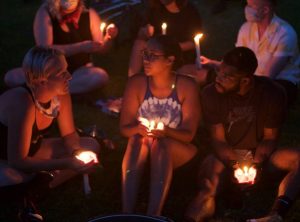
Barbara Rogers Bridges has been an artist and teacher for over 40 years, and creates art from rescued “power objects” with the purpose of provoking reflection and action on a wide variety of social topics. She invites people with different viewpoints to come together and let go of the idea that there is one valid “truth.” Bridges is also the Founder of the non-profit Art To Change The World (ACW, www.arttochangetheworld.org). She believes in inviting ACW members to identify a project and then “leave them alone to lead. The results will be astonishing.”
Bridges believes the murder of George Floyd has sparked a sea change. She is three years into her current Trauma and Healing series and has discovered that “Creating art and ideas together leads to healing.” She strives with ACW for all voices to be heard and to participate. She said, “I am done with silos and echo chambers of thinking.” At the end of the day, week, year, life, it’s all about relationships—interpersonal trust is most important.
